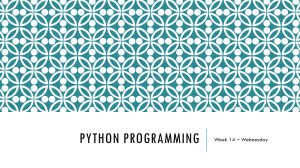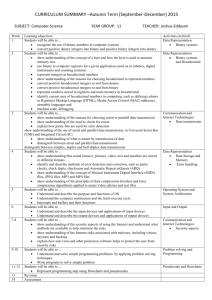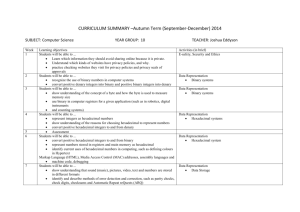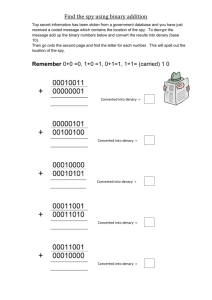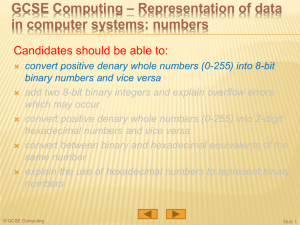Binary, Octary, Denary and Hexadecimal number systems
advertisement
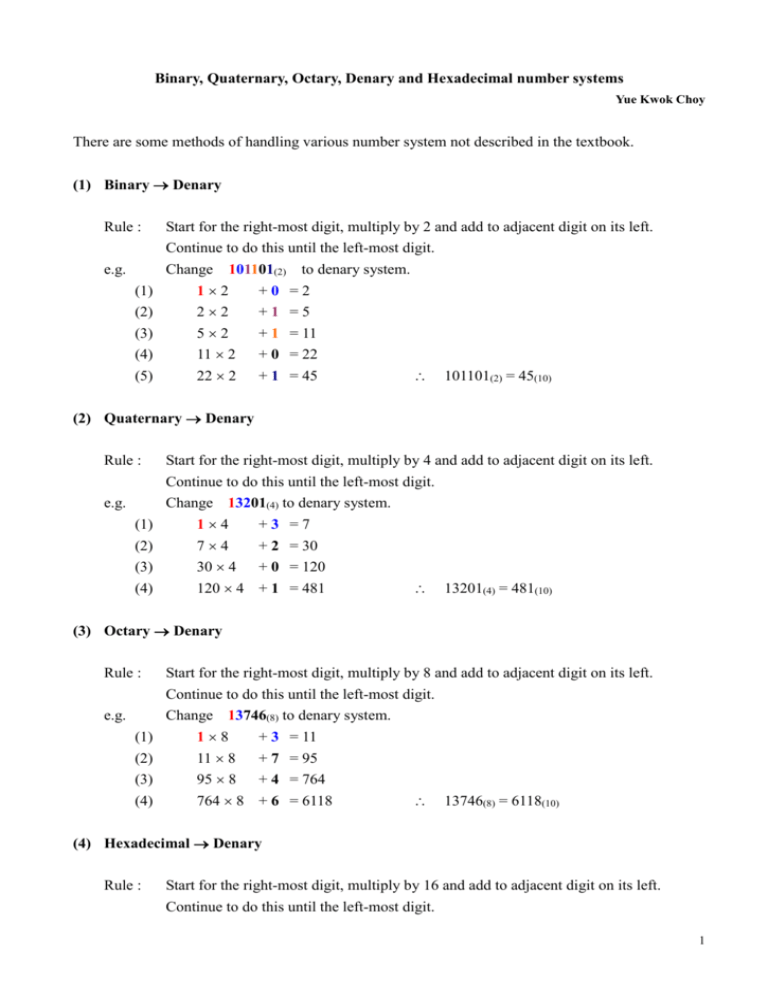
Binary, Quaternary, Octary, Denary and Hexadecimal number systems Yue Kwok Choy There are some methods of handling various number system not described in the textbook. (1) Binary Denary Rule : Start for the right-most digit, multiply by 2 and add to adjacent digit on its left. Continue to do this until the left-most digit. e.g. Change 101101(2) to denary system. (1) 12 +0 =2 (2) (3) (4) (5) 22 52 11 2 22 2 +1 +1 +0 +1 =5 = 11 = 22 = 45 101101(2) = 45(10) (2) Quaternary Denary Rule : Start for the right-most digit, multiply by 4 and add to adjacent digit on its left. Continue to do this until the left-most digit. e.g. Change 13201(4) to denary system. (1) (2) (3) (4) 14 74 30 4 120 4 +3 +2 +0 +1 =7 = 30 = 120 = 481 13201(4) = 481(10) (3) Octary Denary Rule : Start for the right-most digit, multiply by 8 and add to adjacent digit on its left. Continue to do this until the left-most digit. e.g. Change 13746(8) to denary system. (1) (2) (3) (4) 18 11 8 95 8 764 8 +3 +7 +4 +6 = 11 = 95 = 764 = 6118 13746(8) = 6118(10) (4) Hexadecimal Denary Rule : Start for the right-most digit, multiply by 16 and add to adjacent digit on its left. Continue to do this until the left-most digit. 1 e.g. Change A2D7(16) to denary system. (1) 10 16 + 2 = 162 (Note : A(16) = 10(10)) (2) (3) 162 16 2605 16 + 13 = 2605 + 7 = 41687 (Note : D(16) = 13(10)) A2D7(16) = 41687(10) (5) Binary Quaternary Rule : e.g. Starting from the left-most, divide the binary number into groups of two digits. Change binary number in each group to a denary number. Change 1001101(2) to quaternary system. 1|00|11|01(2) = 1| 0 | 3 | 1(4) (6) Binary Octary Rule : e.g. Starting from the left-most, divide the binary number into groups of three digits. Change binary number in each group to a denary number. Change 1001101(2) to octary system. 1|001|101(2) = 1| 1| 5(8) (7) Binary Hexadecimal Rule : Starting from the left-most, divide the binary number into groups of four digits. Change binary number in each group to a denary number (but express in hexadecimal) e.g. Change 1001101(2) to hexadecimal system. 100|1101(2) = 4| D(16) Note that you may use (1) above to help you to calculate. Also note that 1101(2) = 13(10) = D(16) . (8) Quaternary Binary , Octary Binary , Hexadecimal Binary You can do the reverse way of (4), (5), (6) . e.g. (a) 3 | 2| 1| 0(4) (b) 5| 2| 1(8) = 11 | 10 | 01 | 00 (2) = 101|010|001(2) (c) B| 4| 7(16) = 1011|0100|0111(2) (9) Quaternary Hexadecimal Of course you can use the scheme " Quaternary Denary Hexadecimal" or " Quaternary Binary Hexadecimal" 2 But you can also use: Rule : Starting from the left-most, divide the quaternary number into groups of two digits. Change quaternary number in each group to a denary number. (but express in hexadecimal) e.g. 3 2| 1 0(4) = E| 4(16) Note : 32(4) = 14(10) = E(16) . (10) Hexadecimal Quaternary Do in the reverse direction of (8) : e.g. A| B| C| 1(16) = 22| 23| 30| 01(4) Note : A(16) = 10(10) = 22(4) . (11) Octary Hexadecimal, Use either : Octary Quaternary (a) Octary BinaryHexadecimal, Octary Binary Quaternary (b) Octary DenaryHexadecimal, Octary DenaryQuaternary Sometimes method (a) is better! e.g 1. Change 1765(8) to Hexadecimal number. 1765(8) = 1|111|110|101(2) = 11|1111|0101(2) = 3|F|5(12) e.g. 2. Change 123123(4) to Octary number. 123123(4) = 1|10|11|01|10|11(2) = 11|011|011|011(2) = 3333(8) (12) Binary Denary If the binary number is too long, try to do via Quaternary , Octary or even Hexadecimal may sometimes be faster. Compare : 1110110110001(2) = 212 + 211 + 210 + 28 + 27 + 25 + 24 + 20 = 4096 + 2048 + 1024 + 256 + 128 + 32 + 16 + 1 = 7601(10) 1|11|01|10|11|00|01(2) = 1312301(4) , by (5) = 1 46 + 345 + 1 44 + 243 + 342 + 1 = 4096 + 3072 + 256 + 128 + 48 + 1 = 7601(10) 1|11|01|10|11|00|01(2) , or use (1) , or use (2) = 1|31|23|01(4) = 1| D| B| 1(16) = 1 163 + 13 162 + 11 16 + 1 = 4096 + 3328 + 176 + 1 = 7601(10) ,or use (4) 1|110|110|110|001(2) = 16661(8) , by (6) = 1 84 + 6 83 + 6 82 + 6 8 + 1 = 4096 + 3072 + 384 + 48 + 1 = 7601(10) ,or use (3) 3
